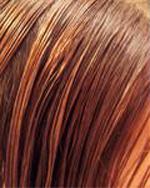|
|
Hair is terribly personal, a tangle of mysterious prejudices. Shana Alexander |
Why people lose hair?

Another factor that has been linked to hair loss is the amount of sebum in the scalp. Sebum contains a high amount of DHT, and clogs pores in the scalp, both of which cause the malnutrition of the hair root. The amount of sebum in balding hair is related to the amount of oil in the hair. Meanwhile most doctors agree that frequent shampooing is advised in hair loss cases with oily scalps. The most important cause of hair loss is inadequate nutrition. Even a partial lack of almost any nutrient may cause hair to fall. But hair grows normally after a liberal intake of these vitamins. A high protein and and an iron rich diet is recommended for hair loss. An adequate intake of raw vegetables, fresh fruits, salads, green leafy vegetables should be included in the diet on a regular basis. Scalp reduction is performed on patients with well-defined bald spots in the crown area of the scalp. It is sometimes done in conjunction with hair transplantaion to reduce the size of the bald scalp, especially in patients who do not have enough donor hair to cover the bald areas. Silicon bags are inserted beneath an area of hairy scalp and gradually inflated with saline water over a six-week period. This causes the hair-bearing skin to stretch, thus increasing the amount of hair-bearing scalp. After removing the bags, expanded hair bearing skin is lifted and moved to an adjacent bald area where a similar sized patch of scalp has been excised. The most familiar hair loss pattern is where the hair begins to recede in the hairline and the crown at roughly the same time. The hair in the mid-scalp or anterior scalp is often the last to go. But go it will, eventually leaving a man with the horseshoe of hair that is the telltale sign of typical male pattern baldness. For women, hair loss is different. There is no set pattern for womens androgenic hair loss, which like MPB, occurs in the overwhelming majority of cases. Women can suffer from alopecia totalis and alopecia universalis just like men. Women can experience patch baldness for the same reasons as men (stress, poor nutrition, etc.), as well as due to hormonal changes from pregnancy and certain eating disorders. However, like men, the hair will generally grow back. The chief difference in womens androgenic hair loss from mens (both are hormone related) is that women tend to experience thinning that occurs in no particular pattern or part of the scalp. Unlike men, the scalp may not actually be totally denuded of hair, just thin to the point where the scalp is visible. Like men, however, the resulting hair loss is generally irreversible. Alopecia Areata - In this type of hair loss, hair usually falls out, resulting in totally smooth, round patches about the size of a coin or larger. It can, rarely, result in complete loss of scalp and body hair. This disease may affect children or adults of any age. The cause of alopecia areata is unknown. Apart from the hair loss, affected persons are generally in excellent health. In most cases, the hair regrows by itself. Dermatologists can treat many people with this condition. Treatments include topical medications, a special kind of light treatment, or in some cases pills. Inadequate Protein in Diet - Some people who go on crash diets that are low in protein, or have severely abnormal eating habits, may develop protein malnutrition. The body will save protein by shifting growing hairs into the resting phase. Massive hair shedding can occur two to three months later. Hair can then be pulled out by the roots fairly easily. This condition can be reversed and prevented by eating the proper amount of protein and, when dieting, maintaining adequate protein intake. Birth Control Pills - Women who lose hair while taking birth control pills usually have an inherited tendency for hair thinning. If hair thinning occurs, a woman can consult her gynecologist about switching to another birth control pill. When a women stops using oral contraceptives, she may notice that her hair begins shedding two or three months later. This may continue for six months when it usually stops. This is similar to hair loss after the birth of a child. See products which may help hair loss. Major Surgery/Chronic Illness - Anyone who has a major operation may notice increased hair shedding within one to three months afterwards. The condition reverses itself within a few months but people who have a severe chronic illness may shed hair indefinitely. Physical and emotional stress might cause hair loss since body is recuperating from an overwhelming turmoil and simply shuts down hair production, thinking that it is not necessary for the body's survival, thereby contributing all energy toward repairing vital body parts. there can be up to three months delay between the major incidence and the actual hair loss. Moreover, there is also period of three months before the loss hair is replaced. This then means there is a total of a minimal of 6 moths for the total hair loss and regrowth cycle. Of course there are things that might contribute to hair loss such as anemia, low blood count, and thyroid abnormalities. Frequently shampooing can dry out your hair and, therefore, must be followed by the use of a moisturizing conditioner. It is very important to work the conditioner through all of your hair and leave it in for three to five minutes. Again, many people misapply and misuse conditioner by not working it through to the ends of the hair and not leaving it on long enough. Excessive exposure to the sun can damage your hair by inducing oxidation of the sulfur molecules within the hair shaft, leaving the hair weak, brittle, dry and faded. People who bleach or lighten their natural hair color may also notice slight color changes in their hair when it is exposed to sun. Blond hair may turn yellow, fade or become dull due to UV exposure. Even natural brunette hair tends to develop reddish hues from sun exposure due to oxidation of melanin pigments. Hair requires the same overall nutrition that the body does: plenty of fresh fruits and vegetables, grains and protein including lean meat and fish. Dietitians recommend foods high in biotin, including brown rice, bulgar, brewer's yeast, soybeans, green peas, lentils, oats, sunflower, seeds and nutritious nuts.
Terms and definitionsScalp Why not go to the site about Love now?
|
|
